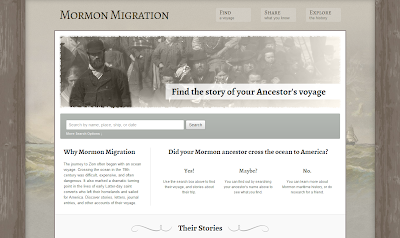For those with LDS Pioneer ancestors, there are websites to find and share information about your family.
The Mormon Migration website is a "remix" of the old Mormon Migration Index CDs. The data from the old cd's has been added upon and put on the site in an easily searchable format.
You can search by name of person, name of ship, or date. A search for the name "John Kelly" yielded the these results:
You would click on the name of the ship (Camillus, above) to access all available resources about the voyage including personal accounts, passenger lists, and (when you're lucky) images of the ship manifest, as seen below:
Wherever you see blue writing on the site, you can click and learn more. The images of passenger lists are also clickable in order to view them larger. You may have to go through several images in order to find the person you're looking for.
If you have information the Mormon Migration website doesn't, you can submit your information and have it considered as an addition to the database. You would click on "Share what you know about this voyage", as seen in blue italicized writing in the center of the image above.
Go to the site, Mormon Migration, and see what you can learn and share about your Mormon Pioneer ancestors. It's a really easy site to navigate...no pun intended!
Thine in the bonds of happy sailing - Caroleen
Showing posts with label Sources. Show all posts
Showing posts with label Sources. Show all posts
Thursday, September 13, 2012
Saturday, April 7, 2012
Source Writing - Don't Let It Scare You!
In the first months of learning how to research my family history, I felt paralyzed by the prospect of writing correct source citations. I wanted to do it right, and the thought of making a mistake kept me from doing anything. I overcame this unfounded fear and have advice for those experiencing similar feelings of anxiety.
2. The purpose of a citation is to get back to the source you are citing. If you can do that, your citation is a success.
3. Attach the information necessary for a source citation to every image you download, print, copy, photograph. You don't want to try to figure out later where you got it.
4. To make source writing easy, use the templates in the most current release of your favorite genealogy database programs. (Rootsmagic and Legacy both attempt to closely follow the standards found in Elizabeth Shown Mill's books Evidence! and Evidence Explained.)
5. In the absence of a template, write down everything you can about your source. You can worry about formatting later.
6. If you want to be professional in your source writing, follow the established and current genealogical standards.
7. Remember that the most correctly written citation does not establish proof. Evaluation of the quality of a source and it's application to the fact you're trying to document could be the subject of a whole other blog post.
Click on the following links for articles, blog posts, and books about source writing:
The Genealogy Source Citation Quick Reference Card - Thomas McEntee
Evidence Explained - The Book - Elizabeth Shown Mills
Evidence Explained - The Website - Elizabeth Shown Mills
The BCG Genealogical Standards Manual (2000) - Board for Certification of Genealogists
Genealogical Standards of Evidence: A Guide for Family Historians - A book by Brenda Dougall Merriman reviewed by Olive Tree Genealogy
An Extensive List of Blog Posts about Citing Sources- Michael Hait blog author of Planting the Seeds
Don't let source writing make you nervous. If you want to do it correctly, there are plenty of resources available to teach you how. If you've been able to find elusive records, you're most certainly able to format a citation. Just like with your research, it all depends on how badly you want it.
Thine in the bonds of wanting it! Caroleen
Subscribe to:
Posts (Atom)


